In athletic recruitment there are these things called ‘Prospect’ camps. Depending on who you talk to these are either just coaching staff supplemental income, or serious recruitment functions needed to get prospective student athletes on campus.
Whatever they are, they’re a little genius!
Here’s how the entire system works. Usually an assistant coach emails your kid, who has a dream to play college athletics, that they are having a prospect camp and you’re invited to attend, for $150. Two things just happened: 1. Your kid just got an email from a college coach; 2. That coach insinuated that your kid is a ‘prospect’! Either way, there’s a good chance you’ll bite and pay the $150.
A couple of things happen at these camps. Coaches actually invite players they really do have interest in, and they invite anyone else who is willing to pay $150! So, a hundred kids show up, two or three which have actual ability to play college athletics, and they go through drills and modified games. You instantly know who has ability because the coaches spend time with those kids. If your kid doesn’t have a coach talking to him or her, they don’t have ability. It’s a real quick and easy way to set your own expectations.
These camps are a necessary evil of the function of recruitment. While most parents don’t like them, they all pay the money and have their kids attend.
These prospect camps got me to thinking if we in HR could do this in our organizations. Could we charge $150 to have potential employees come in and check us out, while we check them out? We run them through some tests, show them our facilities, make them compete against others in their same job function, spend time with our employees. At the end of the day, we offer a couple of them jobs.
Could it work? Maybe not for the average organization, but what about Google or Apple or some other big organization that has thousands wanting jobs with their company? I think it could work. The one issue we face is the expectation. “Well, I paid $150 what do I get for this?!”
We would have to deliver $150 worth of ‘value’ in these Prospective Employee Camps. I think that is probably the easy part. Think interview skills, resume skills, leadership skills, some hardcore job function skills based on what they actually do. It’s part self-development, and part dating game. People pay millions of dollars per to sites to find their perfect romantic match, with most failing to do so.
Prospective Employee Camps might just be a way for your organization to set itself a part from all the noise, and get candidates to come in that truly interested in (I’m willing to pay to be here, truly) and want to be a part of your organization. I know, crazy idea, but when you see it work in one area it just begs to be tried in another!

